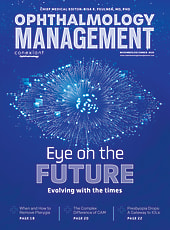Age-related macular degeneration (AMD) and diabetic retinopathy (DR) are leading causes of blindness worldwide.1 Fortunately, medical research has made substantial progress in treating these and other retinal conditions. Historically, retinal diseases that result in abnormal blood flow were treated with laser applied to either leaking or ischemic tissue.2 Ischemia leads to the development of abnormal blood vessels, so retina specialists also utilize intraocular anti-vascular endothelial growth factor (anti-VEGF) injections like bevacizumab (Avastin; Genentech), ranibizumab (Lucentis; Genentech), and aflibercept (Eylea; Regeneron) to control this process.3
Inflammation and edema are additional common pathways of retinal disease, which traditionally have been addressed by the use of steroids such as intra- or periocular triamcinolone acetonide and more recently the dexamethasone implant (Ozurdex; AbbVie).4-6 This article explores newer medical options that we currently, or will soon offer, to our patients in the retina clinic.
Intravitreal Injections
Intravitreal injections are a mainstay of modern medical retina treatment.7 Building on the success of traditional anti-VEGF agents, second generation injectables are now available including high-dose aflibercept (Eylea HD, Regeneron) and faricimab (Vabysmo; Genentech). Faricimab expands upon anti-VEGF inhibition with an additional anti-angiopoietin-2 (Ang-2) target. This dual mechanism may provide greater efficacy and longer treatment durability for patients with diabetic macular edema (DME) or wet AMD than did the first generation agents.8,9 For patients, this can mean less frequent and more potent injections.
For the treatment of dry AMD with geographic atrophy (GA), we now have an emerging suite of treatments based on inhibition of the compliment system.10 Pegcetacoplan (Syfovre; Apellis) is a complement factor 3 and 3b inhibitor, and has demonstrated in the OAKS and DERBY clinical trials the ability to slow the growth of GA with monthly or every-other-month treatment, with an increasing effect over time.11 Avacincaptad pegol (Izervay; Astellas) is a pegylated aptamer that inhibits complement factor 5, and is approved for GA with a monthly injection schedule.12,13 These and related emerging complement inhibitors offer hope to a group who have previously had no therapeutic options.
There are a number of intravitreal injections currently progressing through clinical trials. One example, EYE103 (Restoret; EyeBio), targets the Wnt signaling pathway to stabilize leaking blood vessels in DME and wet AMD. In the AMARONE trial, patients treated with Restoret for DME enjoyed a significant decrease in macular edema with a corresponding gain in visual acuity over 12 weeks of treatment.14
Intravitreal Implants
Intravitreal implants offer sustained drug release for months following injection. The intravitreal dexamethasone implant (Ozurdex; AbbVie)is one such option which, following injection, continues to release steroid medication into the eye for as long as 6 months.15 With repeated doses, this implant can offer long-term clinical stability to patients with DME.16 This implant has also been used as a long-term control option for patients with intraocular inflammation.17 A fluocinolone acetonide intravitreal implant (Illuvien; ANI Pharmaceuticals) is designed to release low-dose steroid to control DME for as long as 3 years.18 Another long term treatment option is the 0.18-mg fluocinolone acetonide implant (Yutiq; ANI Pharmaceuticals), which is designed and approved for long-term control of uveitis up to 3 years.19 By slowly degrading while releasing medication to the retina, intravitreal implants offer long term stability with less frequent dosing than typical monthly injections. Intraocular steroids have been associated with elevations in the intraocular pressure (IOP) of the eye and the development and progression of cataracts.
Suprachoroidal and Port-Delivery
Rather than inject medications into the vitreous cavity, a new approach is to treat the potential space between choroid and sclera. Suprachoroidal triamcinolone acetonide (Xipere; Bausch + Lomb) has been approved for use in cases of non-infectious uveitis with macular edema, demonstrating improvement in visual acuity of 15 or more ETDRS letters at a higher rate than controls and sustained over 24 weeks.20 Suprachoroidal steroids are also being established for the treatment of DME. Oxulumis (Regeneron) is a microcatheter system that delivers triamcinolone acetonide suspension (Triescence; Harrow) where OXU-001 (Regeneron) uses dexamethasone spheres to control macular edema. In the CAPE phase 2 study for Oxulumis and the OXEYE phase 2 study of OXU-001, these treatments are being compared to intravitreal Ozurdex (AbbVie). This space may offer additional options for patients with wet AMD.A phase 2 study is currently underway assessing the safety and efficacy of suprachoroidal tyrosine kinase inhibitor CLS-AX (NCT05891548) for wet AMD.
What Technicians and Staff Should Know About Treating Retinal Disease in a Landscape of Persistent Progress
It is crucial for technicians and staff to stay informed about emerging retinal therapies. This knowledge helps staff address patient questions and concerns more effectively, fostering greater patient trust while improving adherence to treatment plans. New treatments often face adoption barriers including: insurance restrictions, prior authorization requirements, and limited pharmacy support. Technicians play an essential role in overcoming these barriers by researching insurance coverage, pharmacy availability, ordering medications in advance, and by coordinating with company representatives. Staff members who proactively address such challenges ensure a smooth treatment process. By understanding cutting-edge retinal therapies and advocating for patient access, our staff directly contributes to improving patient outcomes.
Another approach to decreasing injection frequency is port-delivery systems (PDS).21 A PDS is a medication reservoir that is surgically implanted through the sclera near the site where intravitreal injections are typically administered. Following implantation, this refillable port continuously elutes medication into the vitreous cavity, eliminating the need for intravitreal administration.22 The ranibizumab PDS (Susvimo; Genentech) is now an FDA-approved treatment for individuals with wet AMD and DME who have previously received at least 2 intravitreal anti-VEGF injections.23
Gene Therapies
The 2017 approval of the first retinal gene therapy24 generated a great deal of excitement for similar future treatments. By delivering a defective gene to the retina, editing defective genetic material in retinal cells, modifying genetic expression profiles, or by altering the cellular functions of the retina to bypass faulty cells, these treatments represent the cutting edge of retina research.25 Another approach to retinal gene therapy is to convert a portion of the retina into an anti-VEGF factory. ABBV-RGX-314 (Regenxbio/AbbVie) is a subretinal or suprachoroidal injection which carries genetic material, allowing for this form of sustained production of anti-VEGF. It is currently being developed as a potential treatment for DR and wet AMD.26 Two other programs from Adverum and 4DMT also use gene therapy approaches for wet AMD, but are delivered via intravitreal injection.27,28
Retinal disease treatment is evolving rapidly, with many promising options around the corner. These developments promise a future of improving outcomes and quality of life for our patients. OP
The authors report no relevant disclosures.
References
- Flaxman SR, Bourne RRA, Resnikoff S, et al. Global causes of blindness and distance vision impairment 1990-2020: a systematic review and meta-analysis. Lancet Glob Health. 2017;5(12):e1221-e1234. doi:10.1016/S2214-109X(17)30393-5
- Reddy SV, Husain D. Panretinal Photocoagulation: A review of complications. Semin Ophthalmol. 2018;33(1):83-88. doi:10.1080/08820538.2017.1353820
- Gunther JB, Altaweel MM. Bevacizumab (Avastin) for the treatment of ocular disease. Surv Ophthalmol. 2009;54(3):372-400. doi:10.1016/j.survophthal.2009.02.004
- Cunningham MA, Edelman JL, Kaushal S. Intravitreal steroids for macular edema: the past, the present, and the future. Surv Ophthalmol. 2008;53(2):139-149. doi:10.1016/j.survophthal.2007.12.005
- Pacella E, Vestri AR, Muscella R, et al. Preliminary results of an intravitreal dexamethasone implant (Ozurdex) in patients with persistent diabetic macular edema. Clin Ophthalmol. 2013;7:1423-1428. doi:10.2147/OPTH.S48364
- Sarao V, Veritti D, Boscia F, Lanzetta P. Intravitreal steroids for the treatment of retinal diseases. ScientificWorldJournal. 2014;2014:989501. Published 2014 Jan 8. doi:10.1155/2014/989501
- Peyman GA, Lad EM, Moshfeghi DM. Intravitreal injection of therapeutic agents. Retina. 2009;29(7):875-912. doi:10.1097/IAE.0b013e3181a94f01
- Goldberg RA, Mar FA, Csaky K, et al. Resolution of angiographic macular leakage with faricimab versus aflibercept in patients with diabetic macular edema in YOSEMITE/RHINE. Ophthalmol Retina. Published online November 22, 2024. doi:10.1016/j.oret.2024.11.015
- Khanani AM, Aziz AA, Khan H, et al. The real-world efficacy and safety of faricimab in neovascular age-related macular degeneration: the TRUCKEE study - 6 month results. Eye (Lond). 2023;37(17):3574-3581. doi:10.1038/s41433-023-02553-5
- Qin S, Dong N, Yang M, Wang J, Feng X, Wang Y. Complement inhibitors in age-related macular degeneration: A potential therapeutic option. J Immunol Res. 2021;2021:9945725. Published 2021 Jul 29. doi:10.1155/2021/9945725
- Heier JS, Lad EM, Holz FG, et al. Pegcetacoplan for the treatment of geographic atrophy secondary to age-related macular degeneration (OAKS and DERBY): two multicentre, randomised, double-masked, sham-controlled, phase 3 trials. Lancet. 2023;402(10411):1434-1448. doi:10.1016/S0140-6736(23)01520-9
- Kang C. Avacincaptad Pegol: First Approval. Drugs. 2023;83(15):1447-1453. doi:10.1007/s40265-023-01948-8
- Zhuang-Yan A, Blair HA. Avacincaptad pegol in geographic atrophy secondary to age-related macular degeneration: a profile of its use. Drugs Ther Perspect 2024;40:293–299.
- Do DV. Restoret (EYE103) for the treatment of diabetic macular edema and neovascular AMD: First-time extended results from the AMARONE phase 1b/2a clinical trial. Presented at: the American Academy of Ophthalmology (AAO) 2024 Meeting. Chicago. October 18-21, 2024.
- Baptiste D, Lam WC, Albiani DA, Yoganathan P, et al. Real-world assessment of intravitreal dexamethasone implant (0.7 mg) in patients with macular edema: the CHROME study. Clin Ophthalmol. 2015;9:1255-1268. Published 2015 Jul 10. doi:10.2147/OPTH.S80500
- Boyer DS, Yoon YH, Belfort R Jr, et al. Three-year, randomized, sham-controlled trial of dexamethasone intravitreal implant in patients with diabetic macular edema. Ophthalmology. 2014;121(10):1904-1914. doi:10.1016/j.ophtha.2014.04.024
- Lowder C, Belfort R Jr, Lightman S, et al. Dexamethasone intravitreal implant for noninfectious intermediate or posterior uveitis. Arch Ophthalmol. 2011;129(5):545-553. doi:10.1001/archophthalmol.2010.339
- Kane FE, Burdan J, Cutino A, Green KE. Iluvien: a new sustained delivery technology for posterior eye disease. Expert Opin Drug Deliv. 2008;5(9):1039-1046. doi:10.1517/17425247.5.9.1039
- Mahmud H, Ahmad TR, Gonzales JA, Stewart JM. Efficacy of the fluocinolone acetonide (Yutiq) intravitreal implant as monotherapy for uveitis [published correction appears in Ocul Immunol Inflamm. 2023 Oct;31(8):1740. doi: 10.1080/09273948.2023.2259280.]. Ocul Immunol Inflamm. 2023;31(8):1603-1607. doi:10.1080/09273948.2022.2076131
- Yeh S, Khurana RN, Shah M, et al. Efficacy and safety of suprachoroidal CLS-TA for macular edema secondary to noninfectious uveitis: Phase 3 randomized trial. Ophthalmology. 2020;127(7):948-955. doi:10.1016/j.ophtha.2020.01.006
- Ranade SV, Wieland MR, Tam T, et al. The Port Delivery System with ranibizumab: a new paradigm for long-acting retinal drug delivery. Drug Deliv. 2022;29(1):1326-1334. doi:10.1080/10717544.2022.2069301
- Chen ER, Kaiser PK. Therapeutic potential of the ranibizumab port delivery system in the treatment of AMD: Evidence to date. Clin Ophthalmol. 2020;14:1349-1355. Published 2020 May 19. doi:10.2147/OPTH.S194234
- Genentech. FDA approves Genentech’s Susvimo as the first and only continuous delivery treatment for the leading cause of diabetes-related blindness. News release. February 4, 2025. https://www.gene.com/media/press-releases/15050/2025-02-04/fda-approves-genentechs-susvimo-as-the-f#:~:text=SUSVIMO%20(ranibizumab%20injection)%20100%20mg,injections%20of%20a%20Vascular%20Endothelial
- US Food and Drug Administration (FDA). FDA approves novel gene therapy to treat patients with a rare form of inherited vision loss. News release. December 18, 2017. https://www.fda.gov/news-events/press-announcements/fda-approves-novel-gene-therapy-treat-patients-rare-form-inherited-vision-loss
- Kovacs KD, Ciulla TA, Kiss S. Advancements in ocular gene therapy delivery: vectors and subretinal, intravitreal, and suprachoroidal techniques. Expert Opin Biol Ther. 2022;22(9):1193-1208. doi:10.1080/14712598.2022.2121646
- AbbVie. AbbVie and REGENXBIO announce updates on the ABBV-RGX-314 clinical program. News release. January 13, 2025. https://news.abbvie.com/2025-01-13-AbbVie-and-REGENXBIO-Announce-Updates-on-the-ABBV-RGX-314-Clinical-Program
- Adverum Biotechnologies. Adverum biotechnologies announces positive preliminary efficacy and safety data from LUNA Phase 2 trial of Ixo-vec in patients with wet AMD. News release. February 8, 2024. https://investors.adverum.com/press_releases/news-details/2024/Adverum-Biotechnologies-Announces-Positive-Preliminary-Efficacy-and-Safety-Data-from-LUNA-Phase-2-Trial-of-Ixo-vec-in-Patients-with-Wet-AMD/default.aspx
- 4D Molecular Therapeutics. 4DMT presents positive interim data from randomized phase 2 PRISM clinical trial of intravitreal 4D-150 demonstrating favorable tolerability & clinical activity in wet AMD. News release. February 3, 2024. https://ir.4dmoleculartherapeutics.com/news-releases/news-release-details/4dmt-presents-positive-interim-data-randomized-phase-2-prism










